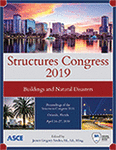Structures Congress 2019
How Levels of Fabrication Precision Can Lead to Improved Quality in Light Frame Wood Construction
Publication: Structures Congress 2019: Buildings and Natural Disasters
ABSTRACT
Wood is one of our most sustainable materials. It requires less energy to produce and deliver to the project location than steel, concrete, masonry, or other materials. Timber products sequester a significant amount of carbon in comparison to the amount of carbon expended during harvest, manufacture, and transport. Timber structures have generally performed well in earthquakes and wind storms if constructed according to the building codes and good construction practice. Timber structures often have a cost advantage over other types of structures. However, “sustainability” is not an “either/or” proposition. A sustainable material can become more sustainable or less sustainable depending on a number of factors. In wood construction, some methods or techniques of manufacture and construction are more sustainable than others. Wood is a sustainable material, and wood structures can be sustainable, but many of these advantages are lost when timber structures perform poorly, fail prematurely, or when the structure needs substantial repair or replacement early in its life cycle. The ASCE/SEI Committee on the Performance of Wood Structures has been charged with determining the controllable effects of material conditions, fabrication, and workmanship on the life-cycle performance of wood structure. The task has been broken into several portions: moisture effects, construction and fabrication, fire, and QA/QC methods. This part examines how fabrication and construction methods or techniques affect the overall performance of a wood structure. Better performance leads to a longer structural life, hence keeping the sequestered carbon bound for a longer period of time. If the useful lifespan of typical wood buildings is increased by reducing the number of defective buildings demolished, then the built wood infrastructure increases. Then the total sequestered carbon in all wood construction increases. This study examines fabrication practices include the effects of poor lumber storage, tolerances in fabrication and fit-up and the effects of assembly and construction error repairs, and how better practices can improve the sustainability of wood structures. These practices will also create a heightened expectation of sustainable wood construction quality and fabrication professionalism which could lead to sustainable wood being used for structures where steel or concrete would otherwise be employed. Lessons learned from these studies can lead to reduced defects in the future and to enhancing the sustainable nature of wood construction. This paper will broaden the knowledge of practicing engineers, preparing them for the challenges of the 21st century. It will assist them to be knowledgeable in factors affecting sustainability and to become better stewards of materials and the built environment.
Get full access to this article
View all available purchase options and get full access to this chapter.
REFERENCES
ACI (American Concrete Institute). ACI 117-10 Specification for Tolerances for. Concrete Construction and Materials. American Concrete Institute.
ACI (American Concrete Institute), “ACI 318-14. Building Code Requirements for Structural Concrete and Commentary.” (2014) American Concrete Institute.
AISC (American Institute of Steel Construction), “Manual of Steel Construction”, (2017) American Institute of Steel Construction.
AISC (American Institute of Steel Construction), “AISC 303-10. Code of standard practice for structural steel buildings and bridges.” (2010) American Institute of Steel Construction.
AISI (American Iron and Steel Institute), “AISI S240-15. North American Standard for Cold-Formed Steel Structural Framing.” (2015).
APA. “ANSI A190.1-2017 Standard for Wood Products — Structural Glued Laminated Timber.” (2017).
BIA (Brick Industry Association), “Brick Veneer/Wood Stud Walls.” Technical Note 28. (2018).
Chen, Helen and Thomas Trestain. “Steel stud brick veneer wall design.” STRUCTURE magazine, pp. 37-39. (2004).
Hohmann and Barnard. “Anchors & Ties (Non-Seismic Veneer).” <www.h-b.com> (2018).
International Code Council, “International Building Code.” (2015).
JELD-WEN. “Installation Instructions for Vinyl Flush Fin Windows and Vinyl Windows with Nailing Fin.” <www.jeld-wen.com> (2018)
Kirkham, William J. “Case Study: Four Story Assisted Living Facility Alleges Unacceptable Design and Construction Defects; What Can We Learn?.” In Structures Congress 2015, pp. 616-626. 2015.
NIST (National Institute of Science and Technology), “Voluntary Product Standard PS 20-15 American Softwood Lumber Standard.”(2015).
SFPA. (Southern Forest Products Association), “Proper Lumber Storage.” <www.southernpine.com> (2018).
SPIB (Southern Pine Inspection Bureau), “Glossary.” <www.spib.com> (2018).
USDA. “Wood handbook-Wood as an engineering material.” General Technical Report FPL-GTR-190, Department of Agriculture, Forest Service, Forest Products Laboratory: USA (2010).
Van Den Bossche, Nathan, and Arnold Janssens. “Airtightness and watertightness of window frames: Comparison of performance and requirements.” Building and Environment 110 (2016): 129-139.
WWPA (Western Wood Products Association), “Lumber Storage and Handling for Lumber Mills, Dealers and Contractors.” <www.wwpa.org> (2018).
Information & Authors
Information
Published In
Structures Congress 2019: Buildings and Natural Disasters
Pages: 66 - 73
Editor: James Gregory Soules, McDermott International
ISBN (Online): 978-0-7844-8222-3
Copyright
© 2019 American Society of Civil Engineers.
History
Published online: Apr 22, 2019
Published in print: Apr 22, 2019
Authors
Metrics & Citations
Metrics
Citations
Download citation
If you have the appropriate software installed, you can download article citation data to the citation manager of your choice. Simply select your manager software from the list below and click Download.
